
kjw
-
Posts
503 -
Joined
-
Last visited
Content Type
Profiles
Forums
Events
Gallery
Store
Articles
Posts posted by kjw
-
-
Unless they're straining, firm is fine. If they're straining, then a bit of tripe, heart, or other organ fed along with your turkey drum will help next time. For some dogs, eggs help too.
-
We'll have to keep our eyes open for some Doggles at GIG for Phene. All fingers and paws crossed for a good outcome!
-
You can definitely use the treats you bought with this last order, likely the lung would be safest if you're feeding a lot of it and he likes it - as I recall he did lol. If he likes the liver better, then use that, but you can effect the stool with liver if you give too much. You want to stick to about 5% of the diet overall with liver - and if it's dehydrated, it's triple what it would be raw (1 oz. raw dehydrated= 3 oz raw. hydrated), so lung would be better if he loves it. Just break it up into tiny pieces, they are just as happy with a tiny piece as they are with a big piece.
I remember seeing a video a while back of a little **zhu, her Mom was giving her little bits of treats and she was in paroxysms of joy every time she got one. Then she got an air treat, and she still had a paroxysm of joy

-
Oh what a beautiful boy! Congratulations, and welcome home Beaker!
-
What a great dog - I just love the strawberry stealing, reminds me of one of my boys. He will clearly never be forgotten - I'm so sorry he had to go.
Run free Tiny, with all our bridge angels.
-
I'm so sorry your beloved boy had to go. One day you'll be able to smile when you think of him, instead of crying, but that takes some time, as many of us know.
Godspeed Howard.
-
Deepest sympathies on the loss of your Princess. What a beautiful girlie she was.
Run free, sweet girl.
 :gh_run2:gh_run2
:gh_run2:gh_run2 -
Lucy, your vet sounds greyt - there's no reason why any vet could not try to hull with this procedure. The elevators really are worth getting, as they seem to be a lot more effecient than anything else I've tried to separate the corn from the surrounding skin.
Karen
About the hulling...my vet had never done it before but he had heard of it. This is how he approached it. He had me soak MoMo's corn foot in an solution of epsom salts & water daily for several days (5) to soften her pad and the corn. I also put Bag Balm on it the pad to keep it moist between the soaks. Then Mo and I went in to the office and soaked that foot in an antiseptic & water solution for a few minutes. Then the vet sat down on the floor with me and we started the hulling procedure.
The soaking had helped give us a clear visual demarcation between corn tissue and paw pad tissue. We had MoMo lie down on a towel on the floor. There was no anesthesia and she was only a tiny bit uncomfortable once during the procedure. He took a dental tool called an elevator (I think) and gently eased the corn tissue away from the healthy pad tissue, going around and around the corn, and going bit deeper each time around, just easing the corn away from the pad. After a quite a bit of this gentle seperation he was able to pull the corn out. There was a very little bit of blood and there probably shouldn't have been any but he and I were learning.
 If the hulling had worked for MoMo we were thinking that they'd order the dental tools for me (the elevators come in different sizes) and I'd do the hulling at home. Having watched it, I think I could have done it myself so it is really not a surgical technique at all, and is not something you should hesitate to try.
If the hulling had worked for MoMo we were thinking that they'd order the dental tools for me (the elevators come in different sizes) and I'd do the hulling at home. Having watched it, I think I could have done it myself so it is really not a surgical technique at all, and is not something you should hesitate to try.Unfortunately, for MoMo the hulling didn't get us even a day free of limping from the corn and the limping it causes.
 However, clearly it is a technique that works for lots of dogs and the sheer number of corns your poor girl has makes this an appealing approach to at least try. The Abreva sounds like a good possibility to pair with the hulling.
However, clearly it is a technique that works for lots of dogs and the sheer number of corns your poor girl has makes this an appealing approach to at least try. The Abreva sounds like a good possibility to pair with the hulling.As for your vet...she was annoyed that you came back yet again for help with painful corns?

 My vet would have been so sorry we were having to come back for painful corns and would have been looking for a new approach to treating them. It might be time to consider looking for a new vet. No one knows everything but having a vet who is willing to research and consult with others and to willingly follow up on information you bring in is vital, IMO, when trying to manage serious health issues. A vet who is not compassionate and who is not willing to look beyond what he/she already knows is worse than useless.
My vet would have been so sorry we were having to come back for painful corns and would have been looking for a new approach to treating them. It might be time to consider looking for a new vet. No one knows everything but having a vet who is willing to research and consult with others and to willingly follow up on information you bring in is vital, IMO, when trying to manage serious health issues. A vet who is not compassionate and who is not willing to look beyond what he/she already knows is worse than useless.--Lucy
-
Run free of pain at the bridge, you sweet girl.
Our condolences to all who loved her.
-
Hey, greyt to see you over here! Scritches to the boys!
-
There's a journal artical on corn hulling in one of the more popular vet journals, so it does seem that your vet isn't keeping up. Sounds like it's time to start trying to find a vet that has experience hulling. The tooth elevators that are used can be found on Ebay, that's where I got mine, and they are really just like rounded flat head screw drivers - they do make it easier to get around the corn. It's really not that hard to do yourself, but barring that, any vet could do it.
I'd be happy to email a copy of the journal artical to you, just PM me your email address.
-
Romi visited once, it was just recently, quite a while after his passing. I saw him lying on the couch, as he has thousands of times before, head hanging over the edge, tongue hanging out with the inevitable ETS. I really expected to see a lot more visits, but there's just been the one, and I'm lucky to have had it.
There are ghost kitties prowling the halls too. I've also seen Lou in the yard several times.
-
Being a bit of a kitchen witch, I'm experimenting with a combination gel I made myself - so far it appears to be slowing the growth rate, but it's only been on for a few weeks. Millie unfortunately has corns on 3 different feet, so I'm able to try 2 different methods and still have a "control" corn to compare results with, so to speak. She used to have more corns, but we managed to treat some homeopathically. Why they didn't all dissappear, to me, supports the multi-factorial theory, it's clear these guys get corns for more than one reason.
Sending lots of healing thoughts out to all our "corn dogs".
-
Jen, you have our deepest sympathies on the loss of your beautiful Miss Echo. She couldn't have been more beloved.
Run free sweet Echo, with Icarus and all the other bridge angels.
-
Deepest sympathies on the tragic loss of Grover. He was certainly loved.
Run free sweet boy!
-
It's the perfect balance of phosphorus to calcium, 1:1. When I fed it to Romi his kidney symptoms eased tremendously; he'd had it all his life, but once his kidneys started up, I cut out organs and bone and he had raw green tripe almost exclusively. Check out the Dog Aware site, link is above, it has excellent information on kidney issues along with many other issue. Mary has done her research on this topic and knows what she's talking about.
-
I met her and her husband Gil at the GRA picnic several years ago, what an amazing couple. I was looking forward to seeing her perform with her hounds again at GIG. The article she wrote about training greyhounds "No Pain, No Fear" has been posted on a bajillion websites - she had a deep insight into the hounds, and will be sorely missed by many, I'm sure.
Godspeed, Kathleen.
-
Brown eggs and white eggs are the same, for sure.
A dog's jaw is actually designed to tear off big chunks of food and get them down their throat quickly so no one else in the pack can get it, so how your dog is eating is instinctual and natural. The only way to slow him down is to feed big meat, so that he has to chew it. If he tries to swallow a piece that's too big, it will come back up and he'll get another shot at it.
When he starts back on bone, you may have to hold onto one end of his RMB to ensure he chews it up properly.
If your dog is getting his 10% bone ground up in his food, he doesn't need the shell from the egg.
We feed raw egg 3 or 4 times a week, and it is a perfect protein. The dogs love them, too!
-
With broken hearts, Michelle and I are sorry to announce the passing of our beautiful boy Romi. After fighting for the last month, he was ready to give up the battle and move on Monday morning. He is survived by his pack Andy, Bailey, Connie and Millie.
We had many years of pure joy from this hound, who was an unexpected addition during the 2004 GRA picnic. He had been at the Hinsdale adoption centre
for over a year, but when I saw him at Bill's with his beautiful big roman nose, and listened to him rooing in his kennel, and experienced him kissing me
right through the bars, I knew this unique character was for us. I have never been sorry that we added him to our pack, he has been at the centre of life at Camp
Greyhound for all of these years, and was a favorite where ever he went.
To say he will be missed is a tremendous understatement.
Thanks to dear friends Dee and Anne for their support yesterday, you made an unbearable day almost manageable; and thanks to Anna our homeopath who made his last month really comfortable.
I imagine Romi arriving at the bridge, and meeting his brother Cantankerous Lou, who pre-deceased him by less than a year, and all the SSGG angels that have left us so recently – Dove, Sadie, Hobbes, Tomtom, Jack, and most recently Hope to name a few. I'm sure he's settled in and is washing everyone's ears right about now.
Goodnight, sweet Prince, til we meet again.

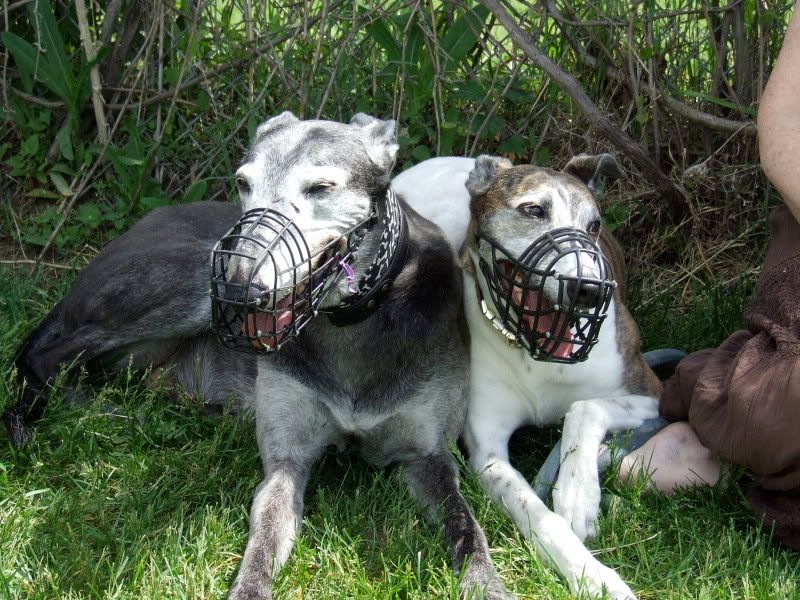

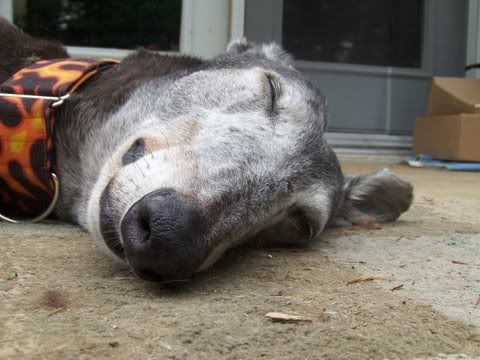
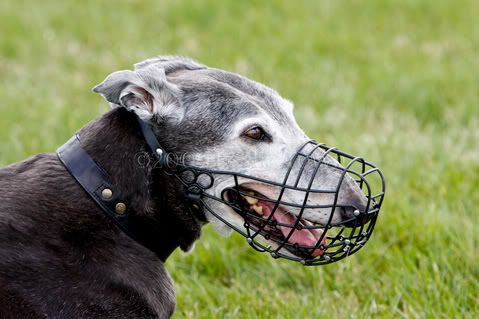

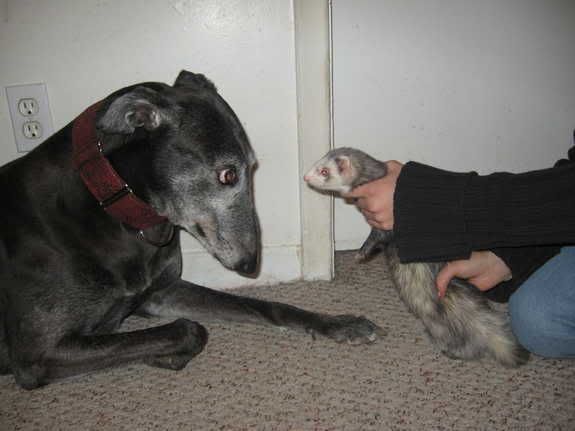
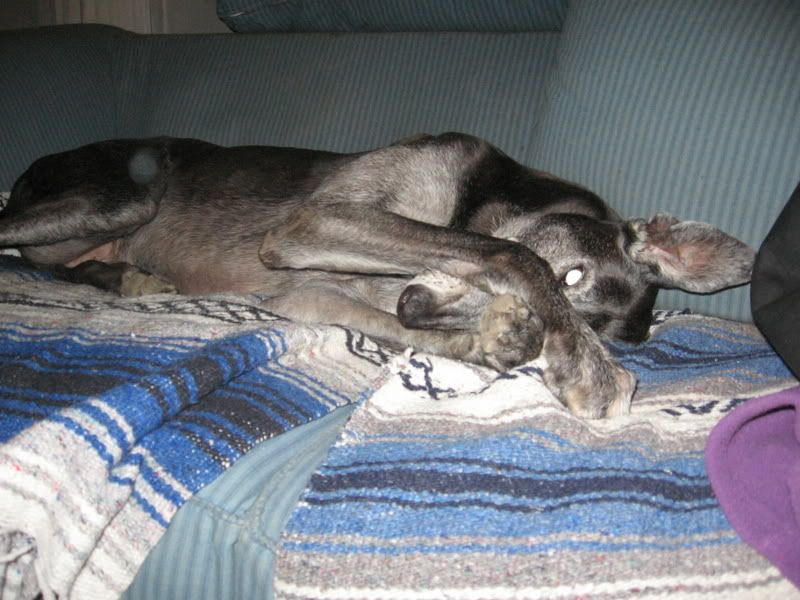

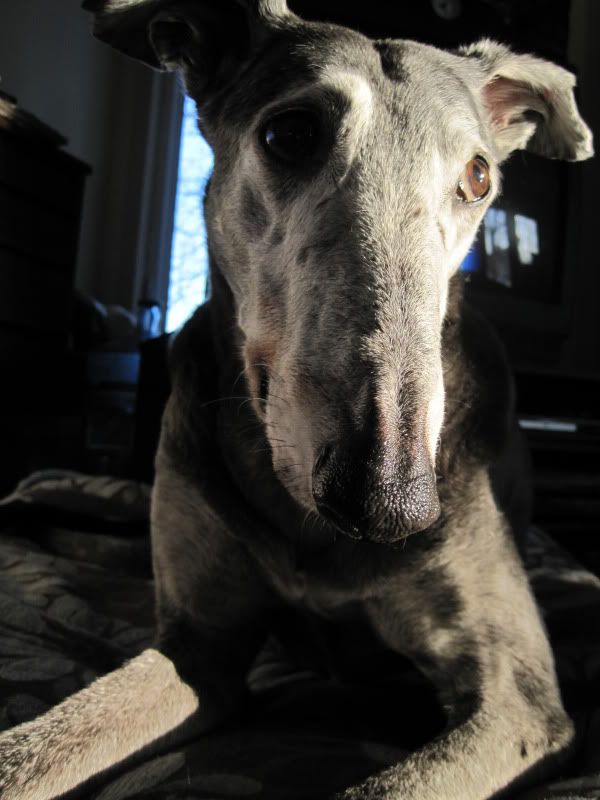
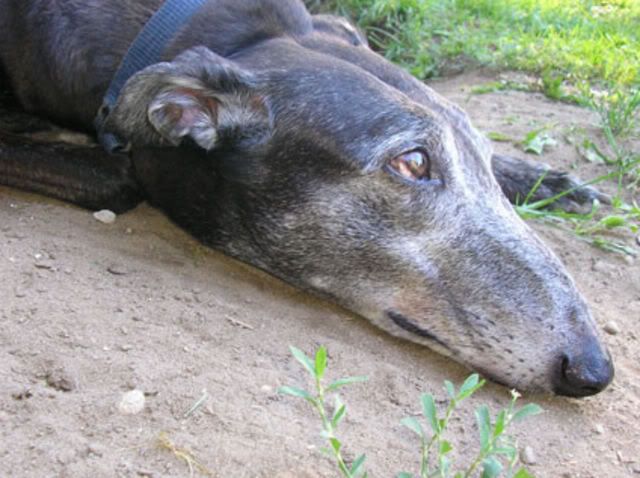

-
Our bridge angel Lou had to be taught for hydrotherapy he had for his dislocated hip, he hated every second of it, but we did manage to teach him.
Easiest way is to get a proper floatation device. You can also hold him while he learns, try to keep his head level rather than pointing up, that's very hard on the neck. Bella may love it, or hate it, you just never know!
-
This is really strange. Astro was licking his foot non stop last night and I checked and I saw the weirdest thing, to me anyway...
His webbing is cut, the skin layer's completely cut in two places but the odd thing is... it's on TOP, not under like it would usually happen if he stepped on something.
I really don't gt it.
And it's not pretty.... And he won't let me touch it.
Any ideas what it is? What I should do?
He likely did it running, their gait totally allows for cuts on the top of the foot or even the webbing. We would just flush it well with colloidal silver, and then spray it anytime he came in from outside. If he's fussing with it, putting a sock on will help (wrap with vet wrap just above the hock, then fold the top of the sock back down) but try not to bandage it, if the air is allowed to get at it it will close up much more quickly.
Scritches to Astro, sounds like it hurts. If you use homeopathics at all, some hypercerium will likely help with that particular pain.
-
We no longer have use vets for cuts, lacs or even punctures unless they are very extensive. We use colloidal silver both topically on wounds - 3x/day initially, and also internally,1 tsp 2-3x/day, this has worked way better for us than antibiotics, with no side effects. Occasionally I will need to tack a laceration if it's large with superglue, but it must be well flushed out first.
We also make extensive use of homeopathics, with Arnica most commonly used initially for shock, trauma, bruising and sometimes muscle strain. Also Hypericum, Ledum, and several others depending on the symptom picture presented. I've treated quite a variety of conditions at home with homeopathics, but there is a learning curve, and it's important to have the help of a good teacher. Learning how to use homeopathics has been a real godsend. This of course, is just what we do here, many others do prefer allopathic methods or using vets.
-
I currently feed some raw (mostly for teeth cleaning purposes) – I gave Twiggy a pork neck bone last night (not the first time), and today she had quite a few large-ish and sharp (!) fragments in her stool. Is this common with pork neck bones? I'm a bit concerned, and may not give her these any more (I think others here feed them sometimes).
I also give turkey/chicken necks, and just bought (and skinned-yech) some chicken leg quarters and drumsticks, as I would like to introduce raw as a larger part of her diet. To that end, I also bought chicken livers, and a package of chicken hearts and gizzards to supplement the clq's and drumsticks.
And now for a stupid question on the hearts/gizzards. As a 25-year veggie, I don't know how to tell the difference. It should be obvious, as I do know what a heart looks like, but in a 1.25 lb pack, I only found one bit that looked like a heart! Most bits looked like several pieces of some sort of organ connected by ligaments. Are the gizzards joined to the hearts and need to be separated out, or by "mostly gizzards" did they mean 99.9% gizzards?? As for why I care which is which – I want to save the hearts to use as the taurine source in a raw recipe for the kitties.
Pork neck bones are a bit dense if you've not been feeding raw for a long time, and also they do tend to cut the necks up so they have sharp edges. 99% of the time these raw bones make it through with no problems; and you will see less and less as your dog starts building up the enzymes needed to totally digest these bones. You might switch to riblets for a while, the bones are a better shape, and the riblets are usually in larger pieces and are more meaty. You do want to feed the meatiest bones you can find.
One of the best taurine sources for kitties is beef heart, my guys really love it. I still have to throw it in the processor for them, they are seniors and will not rip or tear into a large piece, but they really do love beef heart, and pork heart too. Most muscle meats are a good source of taurine, actually better than chicken hearts. Red meats generally trump the beige meats around here for nutrition and taste, too.
Here's a pic of chicken gizzards, which are part of the digestive tract of a chicken, and another pic of a chicken heart.
-
Sending lots of white light from Camp Greyhound to the handsome Flash with the beautiful ears.

Remembering My Zema, Gone A Year
in Remembrance
Posted
What a wonderful memorial, for a gorgeous girilie full of love and life. Unforgettable.